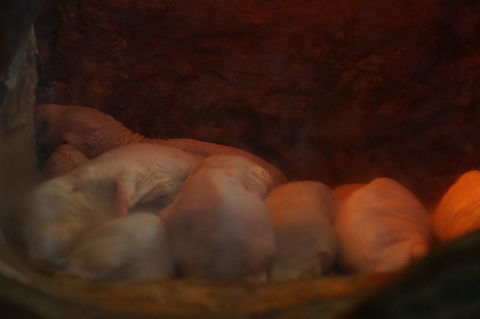
Appearance
Typical individuals are 8 to 10 cm long and weigh 30 to 35 grams . Queens are larger and may weigh well over 50 grams , the largest reaching 80 grams . They are well-adapted to their underground existence. Their eyes are quite small, and their visual acuity is poor. Their legs are thin and short; however, they are highly adept at moving underground and can move backward as fast as they can move forward. Their large, protruding teeth are used to dig and their lips are sealed just behind the teeth, preventing soil from filling their mouths while digging. About a quarter of their musculature is used in the closing of their jaws while they dig - about the same proportion that is utilized in the human leg. They have little hair and wrinkled pink or yellowish skin. They lack an insulating layer in the skin.Its karyotype has 2n = 60.
Distribution
The naked mole-rat is native to the drier parts of the tropical grasslands of East Africa, predominantly southern Ethiopia, Kenya, and Somalia.Clusters averaging 75 to 80 individuals live together in complex systems of burrows in arid African deserts. The tunnel systems built by naked mole-rats can stretch up to three to five kilometres in cumulative length.
Status
Naked mole-rats are not threatened. They are widespread and numerous in the drier regions of East Africa.Habitat
The naked mole-rat is native to the drier parts of the tropical grasslands of East Africa, predominantly southern Ethiopia, Kenya, and Somalia.Clusters averaging 75 to 80 individuals live together in complex systems of burrows in arid African deserts. The tunnel systems built by naked mole-rats can stretch up to three to five kilometres in cumulative length.
Food
Naked mole-rats feed primarily on very large tubers that they find deep underground through their mining operations. A single tuber can provide a colony with a long-term source of food—lasting for months, or even years, as they eat the inside but leave the outside, allowing the tuber to regenerate. Symbiotic bacteria in their intestines ferment the fibres, allowing otherwise indigestible cellulose to be turned into volatile fatty acids.Naked mole-rats sometimes also eat their own feces. This may be part of their eusocial behavior and a means of sharing hormones from the queen.
References:
Some text fragments are auto parsed from Wikipedia.